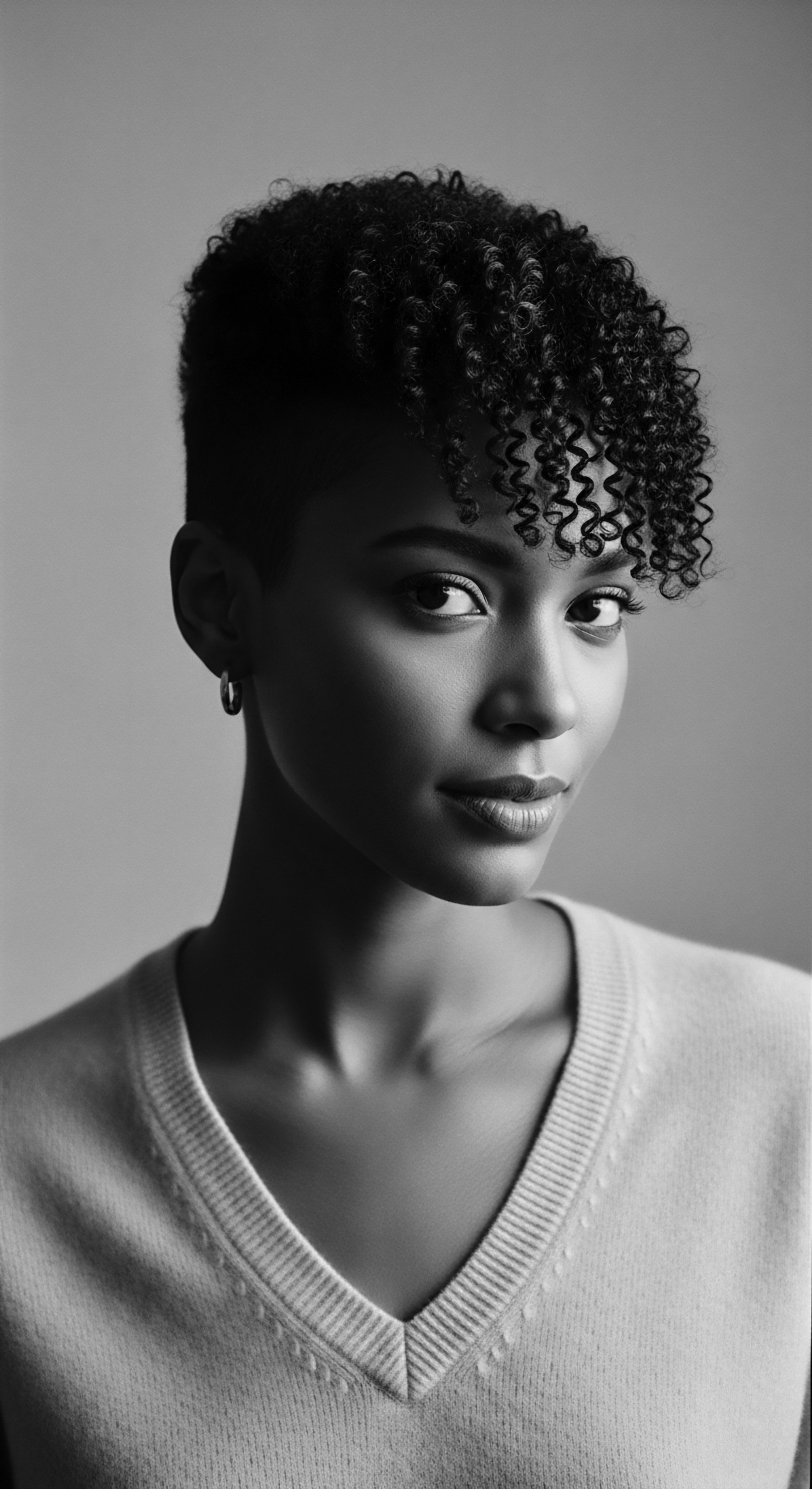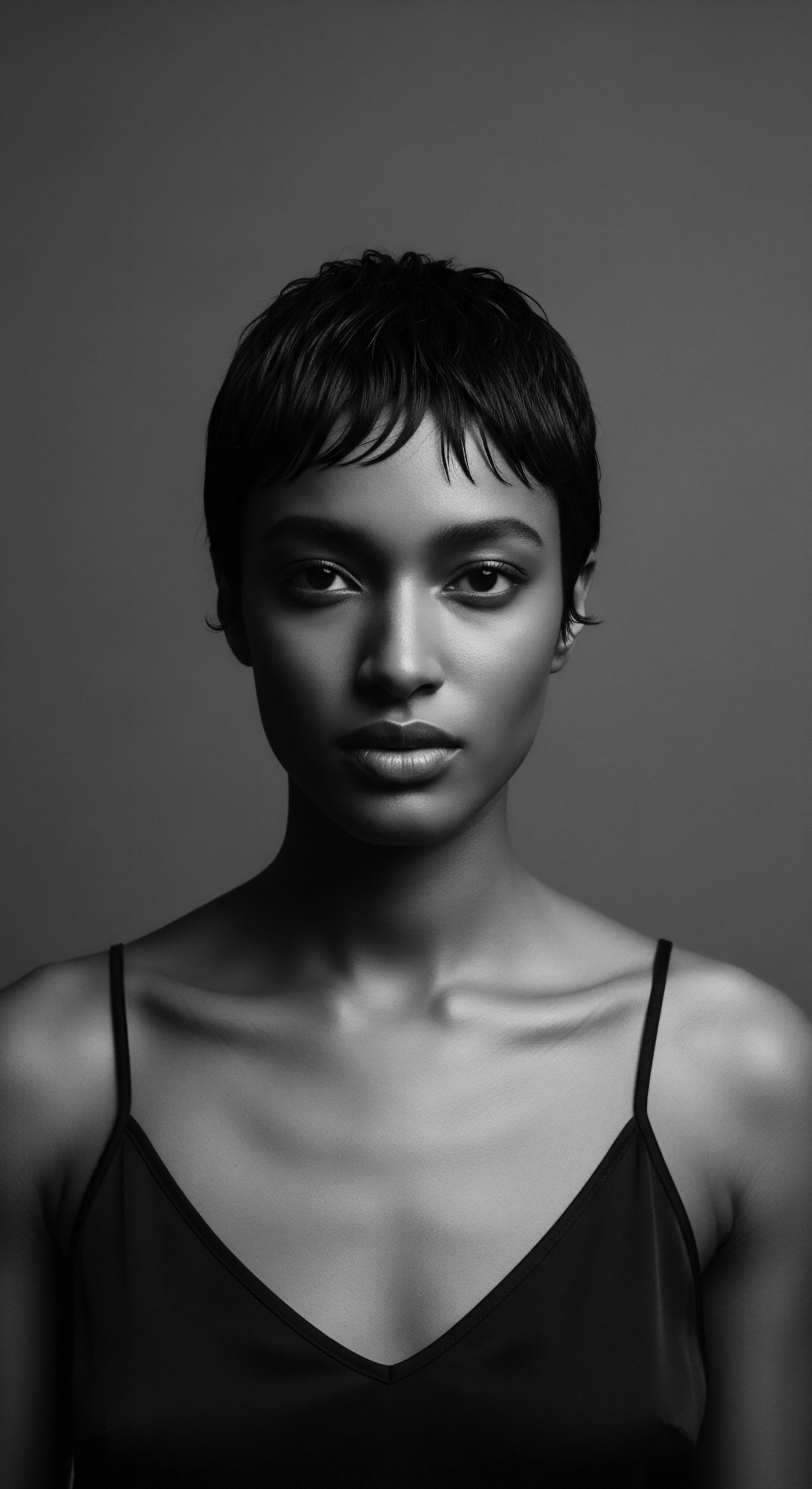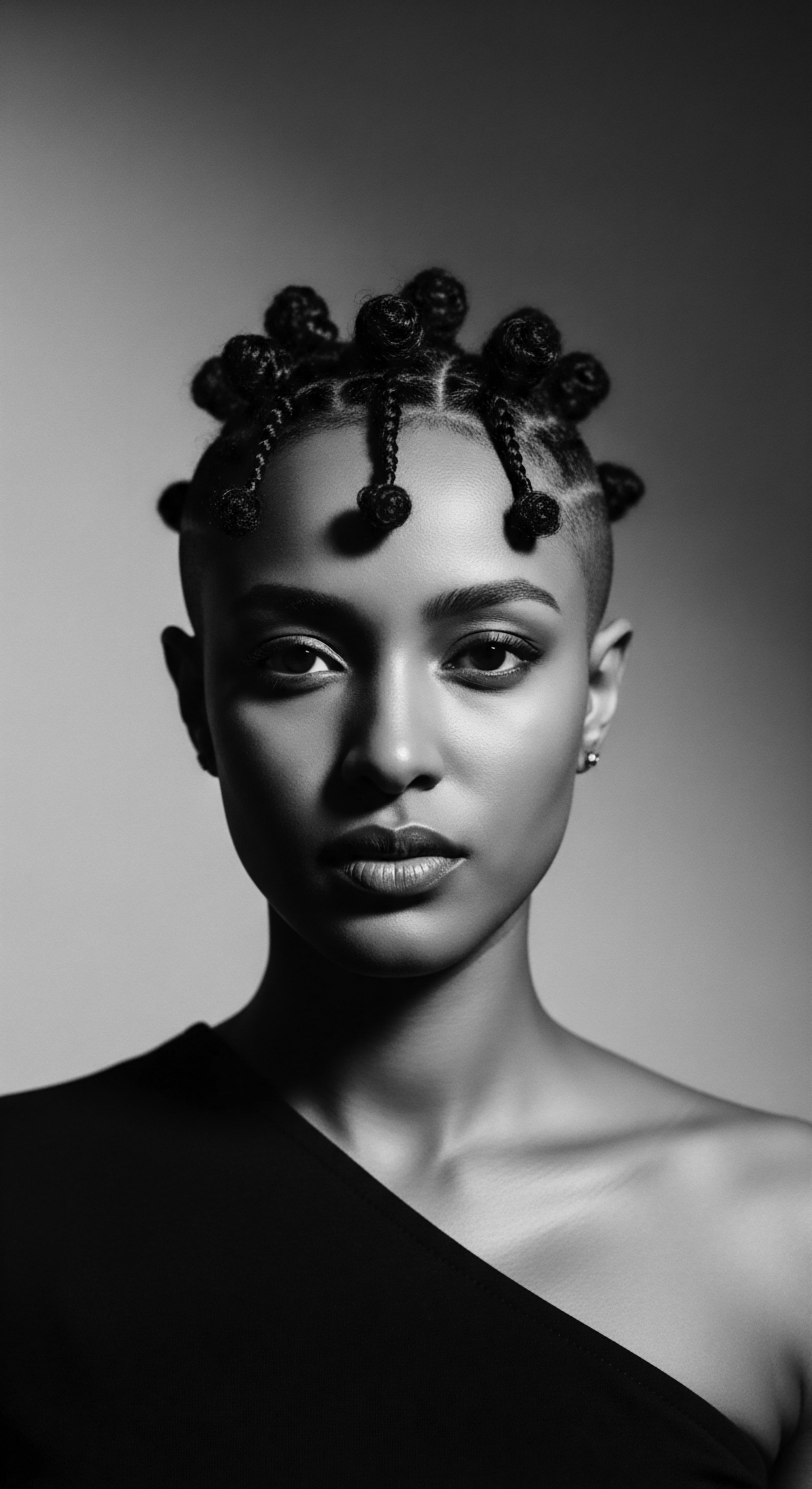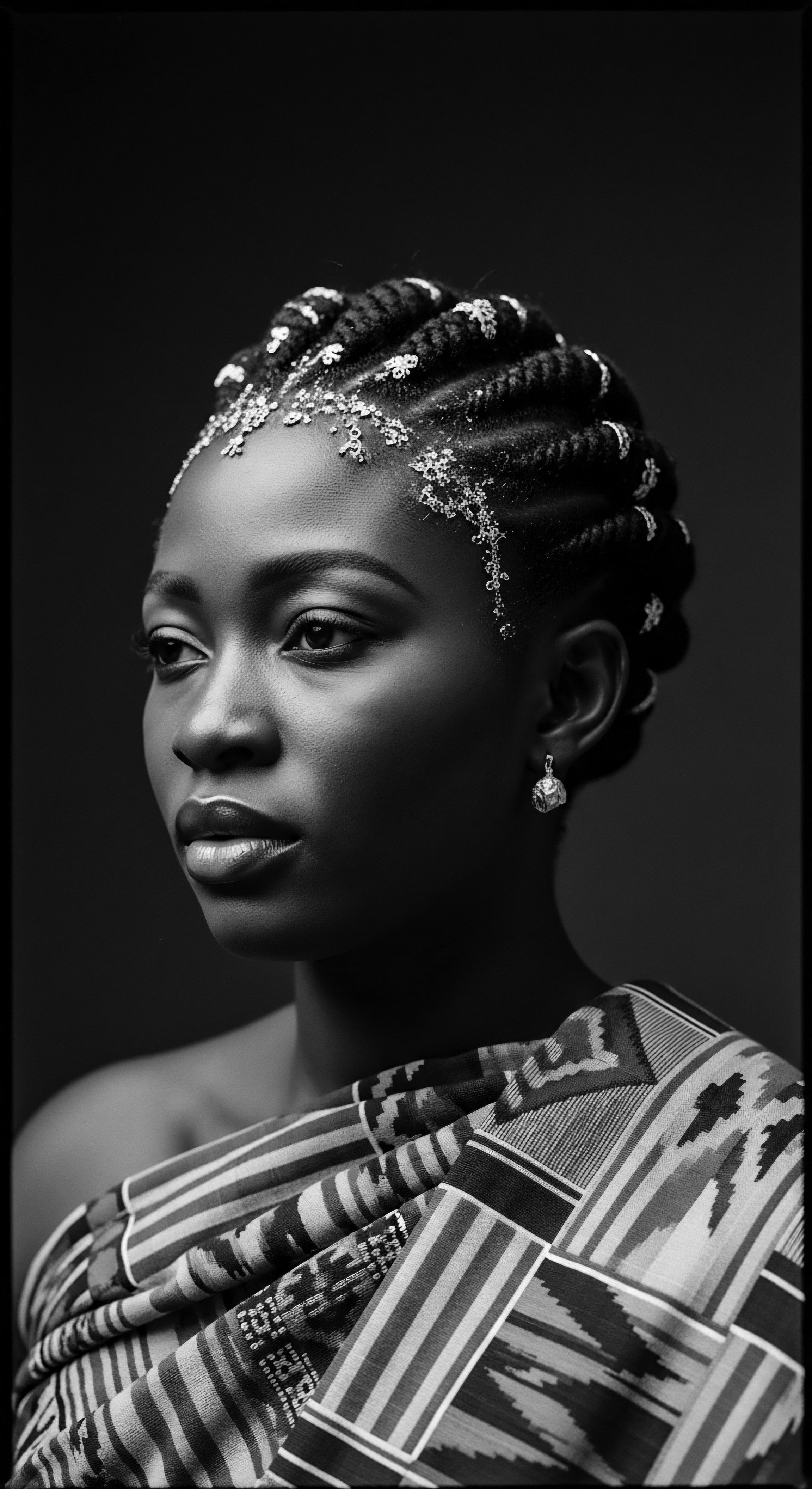
Roots
The journey of textured hair, a story written in spirals and coils across continents and through generations, holds within its very structure the whispers of ancient earth. For those whose strands bear the indelible mark of heritage, the connection to natural elements runs deep, a living testament to ancestral wisdom. We find ourselves drawn to the very ground beneath our feet, to the pigments and minerals that once adorned our forebears, shaping their identity and protecting their crowns. Among these, red ochre stands as a sentinel of time, its fiery hue a beacon from antiquity, calling us to understand its place in the legacy of textured hair care.
This vibrant earth pigment, primarily composed of iron oxides , particularly hematite, alongside varying amounts of silica and clay, carries within its elemental makeup a story of resilience and inherent benefit. It is not merely a coloring agent, but a complex natural compound, whose mineral composition has interacted with the diverse anatomies of textured hair for millennia. Understanding these foundational components allows us to truly appreciate the profound relationship between the earth’s bounty and the inherent strength of our hair.

Hair’s Elemental Composition and Ochre’s Gifts
The intricate architecture of a single hair strand, from its visible shaft to its hidden follicle, relies on a delicate balance of proteins, lipids, water, and indeed, minerals. While keratin forms the dominant protein backbone, minerals like zinc, copper, and iron play their own vital roles in maintaining hair structure and color. It is into this biological symphony that the mineral composition of red ochre steps, offering contributions that echo practices from the earliest human settlements.
The iron oxide within red ochre, notably ferric oxide (Fe2O3), provides more than just its characteristic reddish tint. This mineral acts as a physical barrier, offering a form of natural sun protection against the sun’s harsh rays, a benefit documented in contemporary scientific study validating ancestral observations. For textured hair, often more susceptible to moisture loss and environmental stressors due to its structural characteristics, this protective shield would have been invaluable in arid climates where many ancestral communities resided.
Beyond defense, iron itself contributes to hair health, playing a part in the production of melanin, the very pigment responsible for hair color. A deficiency in iron can impact hair’s overall vitality, underscoring the subtle but significant role this mineral can play when applied topically through earth pigments.
Red ochre’s mineral composition, particularly its iron oxides, offers historical and scientific avenues for understanding its protective and strengthening qualities for textured hair.
Moreover, red ochre often contains silica , a mineral crucial for the production of keratin, the fundamental protein that gives hair its strength and elasticity. Silica aids in building keratin, making hair more resistant to damage and breakage, and can contribute to improved elasticity and shine. For textured hair, which naturally possesses varied curl patterns that create points of vulnerability along the strand, enhancing elasticity and strength is paramount.
The presence of clay minerals, such as illite, kaolin, and montmorillonite, further lends red ochre its absorbent and remineralizing qualities, drawing out impurities while providing beneficial trace elements to the scalp and hair fiber. This multi-mineral synergy from the earth itself provides a holistic approach to hair care, one that ancestral communities understood intuitively.

The Deep Heritage of Hair Classification
When we speak of textured hair, we acknowledge a spectrum of curl patterns, from gentle waves to tightly coiled strands. While modern classification systems exist, the heritage of understanding hair extends far beyond simple numbering or letter designations. Ancestral communities possessed their own nuanced lexicons for describing hair, often linked to its appearance, health, and cultural significance. The very act of applying substances like red ochre would have been intertwined with these classifications, recognizing how the pigment interacted with different hair types within a community.
The resilience of textured hair, often seen as a direct inheritance, has been safeguarded through practices that intuitively aligned with its unique physiological needs. The minerals within red ochre provided not just aesthetic enhancement but a tangible shield, allowing strands to maintain their integrity against the elements. This foundational understanding, that the earth holds remedies for our hair’s well-being, is a cornerstone of textured hair heritage.
| Mineral Component Iron Oxide (Hematite) |
| Traditional Understanding Sun protection, symbolic color, ritualistic significance. |
| Contemporary Scientific Insight Physical UV barrier, contributes to hair pigment, fortifies against environmental damage. |
| Mineral Component Silica |
| Traditional Understanding Associated with strong, healthy growth, often found in beneficial clays. |
| Contemporary Scientific Insight Aids keratin production, improves hair strength, elasticity, and can regulate scalp oil. |
| Mineral Component Clay Minerals (e.g. Kaolin, Illite) |
| Traditional Understanding Cleansing, drawing out impurities, soothing scalp. |
| Contemporary Scientific Insight Absorbent, remineralizing, can cleanse scalp and hair fiber. |
| Mineral Component This table illustrates the enduring wisdom of ancestral practices, where intuitive use of earth's elements for hair care finds validation in modern scientific understanding. |

Ritual
To stand at the threshold of ritual, particularly where hair is concerned, is to approach a living archive of human experience. We recognize the profound yearning to connect with practices that have shaped our ancestors, those gentle hands that once prepared red ochre for the care of textured hair. This section steps beyond the mere composition of the pigment, inviting a deeper consideration of how red ochre, in its various applications, became a central character in the ongoing narrative of textured hair styling and protection. It is a story not of rigid rules, but of adaptable wisdom, passed through generations, evolving yet retaining its core reverence for the strand.
Across diverse African and Indigenous communities, the preparation and application of red ochre for hair was rarely a solitary act; it was often a communal ritual, a moment of connection and cultural reinforcement. The Himba people of northern Namibia stand as a luminous example, their daily practice of anointing hair and skin with otjize —a paste of red ochre and butterfat—a testament to this enduring tradition. This mixture, beyond its aesthetic appeal, served as a multi-purpose balm, offering protection from the harsh desert sun and repelling insects, while conditioning the hair. The very act of its application became a form of protective styling, a deliberate act of care that preserved the hair’s integrity in challenging environments.

How Does Red Ochre Influence Hair Styling and Protection?
The impact of red ochre on textured hair styling is not confined to a single method; rather, it manifests in several significant ways, each reflecting an ancestral ingenuity that prioritized both beauty and preservation. The paste, when applied, coats the hair shaft, providing a physical layer that shields it from external aggressors. This external coating, particularly from the iron oxides , helps to reflect harmful ultraviolet rays, much like a natural sunscreen. For coils and curls, which can be vulnerable to sun damage and subsequent drying, this protective layer was a vital defense mechanism.
Beyond sun protection, the fatty component often mixed with red ochre—such as butterfat or animal oils—provided deep conditioning, sealing moisture into the hair strand. This combination would have softened the hair, making it more pliable and less prone to breakage, particularly during the intricate braiding or twisting techniques common in textured hair styling. The very act of applying this mixture would have aided in detangling and smoothing the hair, contributing to its manageability and overall health. The practice of using such a paste can be seen as an early form of hair masking, a deeply conditioning treatment that both fortified and beautified.
Consider the Beothuk people of Newfoundland, who, while known for their body painting with red ochre, also used it for other purposes, including possibly for hair coloring. The use of such pigments in different contexts underscores a shared understanding across diverse cultures regarding the protective and transformative qualities of earth’s pigments. This ancestral knowledge, often passed down through oral traditions and communal practices, holds wisdom that contemporary hair care can still glean from.
- Otjize ❉ The Himba’s signature paste of red ochre and butterfat, applied daily for sun protection, insect repulsion, and hair conditioning.
- Wilgi ❉ The Noongar people of southwestern Australia mixed ochre with animal fat to create this unguent, used for skin protection and potentially hair adornment.
- Isibhindi ❉ The Xhosa nation in South Africa used red ochre, known as Isibhindi, for skin ailments and as a sunscreen, practices that would naturally extend to scalp and hair care.

The Tools of Tradition and Transformation
The tools employed in these rituals were often simple yet profoundly effective, born from an intimate understanding of the natural world. Grinding stones to reduce ochre into a fine powder, mixing vessels crafted from gourds or wood, and the hands themselves—these were the instruments of transformation. The rhythmic motion of preparing the paste, the tactile sensation of applying it, all contributed to a sensory experience that deepened the connection to the material and the heritage it represented. This hands-on approach stands in contrast to many modern hair care routines, inviting a moment of mindfulness and reverence for the process.
The act of incorporating red ochre into hair care routines also speaks to a deeper cultural purpose ❉ the adornment of the body as a canvas for identity and belonging. The rich, earthy red not only provided physical benefits but also carried symbolic weight, signifying status, readiness for ceremonies, or connection to ancestral spirits. This blending of function and symbolism is a hallmark of traditional practices, where beauty was inseparable from well-being and cultural expression.
Red ochre’s role in ancestral hair rituals transcends mere aesthetics, providing both tangible protection and profound cultural expression for textured hair.
The evolution of hair care practices, from these ancient rituals to contemporary methods, shows a continuous thread of seeking optimal health and beauty for textured hair. While modern science has provided new formulations and understandings, the wisdom embedded in the traditional uses of red ochre offers a powerful reminder of the efficacy and holistic nature of ancestral care. It prompts us to consider how we might re-engage with the earth’s offerings, honoring the legacy of those who first discovered their profound benefits.

Relay
How does the ancient wisdom of red ochre, steeped in the ancestral practices of textured hair care, speak to the complexities of modern understanding and the ongoing narrative of cultural identity? This inquiry invites a sophisticated exploration, moving beyond surface-level descriptions to consider the profound interplay of elemental biology, human ingenuity, and enduring cultural legacies. The journey of red ochre from geological deposit to revered cosmetic and protective agent reveals layers of insight into holistic well-being and the deep cultural intelligence embedded within textured hair heritage.
The scientific validation of traditional uses for red ochre, particularly its photoprotective qualities, offers a compelling testament to ancestral observational knowledge. Research in 2015, for instance, examined the red ochre used by the Himba, finding that its high iron oxide content, coupled with fine grain sizes, provided substantial sun protection (Rifkin, 2015). This study underscores how generations of empirical observation led to practices that modern science now confirms as highly effective.
The iron oxides within the pigment act as a physical blocker, reflecting and scattering ultraviolet radiation, thereby shielding the hair and scalp from environmental degradation. For textured hair, which can be more susceptible to protein degradation and color fading from sun exposure, this ancestral shield offered a critical defense.

What Specific Mineral Interactions Benefit Textured Hair?
The benefits derived from red ochre extend beyond simple physical protection, reaching into the subtle biochemical interactions between its mineral components and the hair’s structure. Consider the role of iron within the hair itself. Hair contains various minerals, including iron, which are integral to its structure and pigmentation.
While direct absorption of iron from topical red ochre into the hair shaft in significant quantities is a subject of ongoing research, the consistent application of a mineral-rich substance to the scalp could contribute to a healthy microenvironment. A healthy scalp, in turn, supports robust hair growth, particularly for textured hair, which often benefits from consistent moisture and a balanced scalp microbiome.
Furthermore, the silica present in red ochre, often derived from its clay components, is a vital trace element for hair health. Silica supports the synthesis of keratin, the primary protein of hair, contributing to its strength, elasticity, and resilience. For textured hair, characterized by its unique curl patterns and propensity for breakage at the points of curvature, enhanced elasticity is a critical factor in preventing damage.
Silica also plays a role in regulating scalp oil, which can help in maintaining a balanced scalp environment, a key aspect of holistic hair care. The combination of iron and silica in red ochre, therefore, speaks to a dual action ❉ external protection and potential internal fortification through sustained, traditional application.
- Iron Oxide ❉ A primary component, offering natural UV protection and contributing to the pigment’s ability to fortify hair against environmental elements.
- Silica ❉ Present in the clay base, supporting keratin synthesis and enhancing hair’s elasticity and strength.
- Clay Minerals ❉ Illite, kaolin, and montmorillonite provide cleansing and remineralizing actions, drawing out impurities and soothing the scalp.

Ancestral Ingenuity Validated by Modern Inquiry
The practice of mixing red ochre with butterfat, as seen with the Himba’s otjize, also presents a sophisticated understanding of material science. The lipids in butterfat create an occlusive layer that seals moisture into the hair, mitigating the drying effects of arid climates. This combination of mineral pigment and lipid acts as a highly effective emollient and protective barrier, a formulation that predates modern cosmetic science by centuries. This synergy between the mineral and the organic binder is a testament to ancestral ingenuity, a practical application of environmental resources for optimal hair health.
The historical use of red ochre in textured hair care represents a profound, empirically validated understanding of mineral benefits for hair health and cultural expression.
The historical continuity of these practices, even in the face of colonial disruptions and modern advancements, speaks to their enduring value. The symbolism of red ochre—often associated with blood, life, and connection to the earth—intertwines deeply with its functional benefits, elevating hair care from a mere cosmetic act to a profound cultural statement. For many Black and mixed-race communities, the use of such ancestral elements is a deliberate act of reclaiming and honoring heritage, a visible link to the resilience and wisdom of their forebears.
| Aspect of Benefit Sun Protection |
| Traditional Understanding and Application Himba women apply otjize daily to shield hair and skin from desert sun. |
| Scientific Explanation and Impact on Textured Hair Iron oxides act as physical UV blockers, reflecting radiation and protecting hair protein from degradation and color fade. |
| Aspect of Benefit Hair Strength & Elasticity |
| Traditional Understanding and Application Observed hair resilience and vitality in communities using ochre, often linked to the earth's inherent power. |
| Scientific Explanation and Impact on Textured Hair Silica supports keratin structure, making hair more resistant to breakage, particularly at the bends of textured strands. |
| Aspect of Benefit Scalp Health & Cleansing |
| Traditional Understanding and Application Used as a medicinal salve to clean hair and repel insects. |
| Scientific Explanation and Impact on Textured Hair Clay minerals absorb impurities and excess oil, promoting a balanced scalp environment, while potential antimicrobial properties of iron oxides could help. |
| Aspect of Benefit Conditioning & Moisture Retention |
| Traditional Understanding and Application Mixed with butterfat to create emollient pastes for skin and hair. |
| Scientific Explanation and Impact on Textured Hair Lipids from butterfat or oils seal moisture into the hair shaft, reducing dryness and enhancing pliability for styling. |
| Aspect of Benefit The enduring utility of red ochre in textured hair care highlights a sophisticated blend of cultural practice and natural science, where ancestral wisdom often prefigured contemporary understanding. |
The narrative of red ochre and textured hair is a vibrant thread in the larger tapestry of human adaptation and cultural expression. It speaks to the ingenuity of communities who, drawing from the earth’s own palette, found ways to protect, nourish, and adorn their hair, transforming simple minerals into agents of beauty, health, and profound cultural connection. This legacy invites a continued reverence for the elements and the ancestral knowledge that understood their deepest gifts.

Reflection
The enduring presence of red ochre in the story of textured hair care, stretching from the deep past into the present, is a powerful testament to the ‘Soul of a Strand’ ethos. It is a profound meditation on the resilience of cultural practices and the intrinsic wisdom held within ancestral traditions. We witness how a simple earth pigment, born of iron and clay, became a cornerstone of beauty, protection, and identity for diverse communities with textured hair. The crimson hue of ochre, once a symbol of life and connection to the land, continues to remind us that the most profound care often originates from the earth itself.
This exploration of red ochre is more than a historical survey; it is an invitation to reconnect with the elemental foundations of our being, recognizing that our hair, in its glorious textured forms, carries a legacy of adaptation and inherent strength. The knowledge passed down through generations, often through the silent language of ritual and practice, speaks to a holistic approach where the well-being of the hair was intertwined with the health of the individual and the spirit of the community. As we look to the future of textured hair care, the echoes of red ochre remind us that innovation can also mean a return to source, honoring the enduring wisdom of our collective heritage.

References
- Rifkin, R. F. (2015). Ethnographic and experimental perspectives on the efficacy of red ochre as a mosquito repellent. Journal of Human Evolution, 84, 117-128.
- Holly, D. H. Jr. & Loring, S. (2009). The Historical Use of Ochre Pigments in Newfoundland and Labrador. Labrador Institute of Northern Studies.
- Wouters, J. (1990). Ancient Egyptian Textiles ❉ The Evidence of Dyestuffs. Centre for Conservation and Archaeology, University College London.
- Baduel, N. (2008). The Use of Ochre in Predynastic Egypt. British Museum Press.
- Tamburini, F. et al. (2001). The Study of Ancient Egyptian Textile Dyes. The Textile Museum.
- Spencer, B. & Gillen, F. J. (1927). The Arunta ❉ A Study of a Stone Age People. Macmillan and Company.
- Strehlow, T. G. H. (1947). Aranda Traditions. Melbourne University Press.
- Nind, S. (1831). Description of the Natives of King George’s Sound (Swan River Colony) and Adjoining Coasts. Colonial Office.
- Austin, R. (1841). Journal of an Expedition from Yuin to the Country of the Aborigines. The Perth Gazette.
- Moore, G. F. (1842). A Descriptive Vocabulary of the Language in Common Use Amongst the Aborigines of Western Australia. Charles Tilt.
- Drummond, J. (1840). Botanical Remarks. The Perth Gazette.
- Grey, G. (1840). Journals of Two Expeditions of Discovery in North-West and Western Australia, During the Years 1837, 38, and 39. T. and W. Boone.
- Tönjes, H. (1911). Ovamboland ❉ Land, Leute, Mission. Verlag von Martin Warneck.
- Galton, F. (1853). Narrative of an Explorer in Tropical South Africa. John Murray.
- Thunberg, C. P. (1775). Travels in Europe, Africa, and Asia Made Between the Years 1770 and 1779. W. Richardson.
- Campbell, J. (1815). Travels in South Africa. Black, Parry, and Co.
- Gilbert, K. (2009). Hair and Hairdressing in Aboriginal Australia. Aboriginal Studies Press.
- Pettitt, P. (2018). The Neanderthals and the Modern Human Colonization of Europe. Cambridge University Press.
